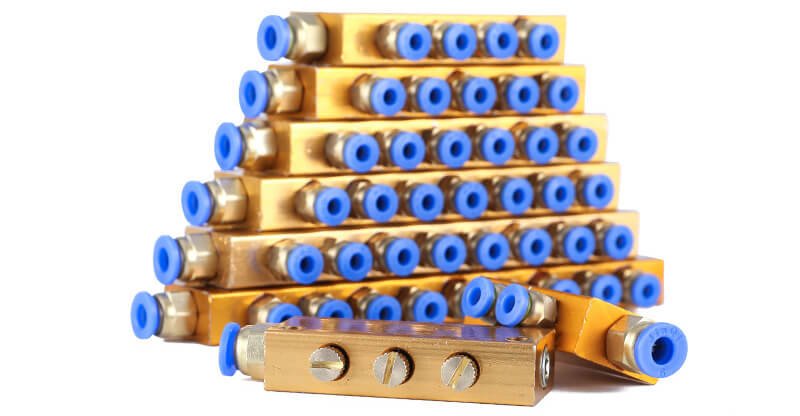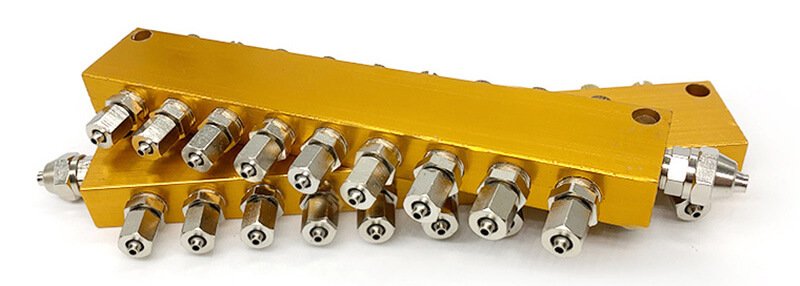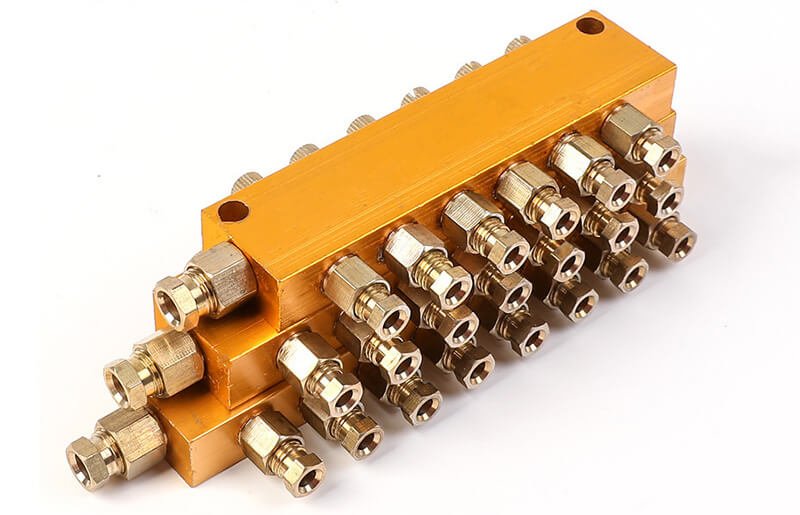In many industrial environments, pneumatic systems are essential for driving machinery and automating processes. These systems rely on compressed air to power various components like actuators and valves. However, to ensure smooth and efficient operation, proper lubrication of the system is required. This is where an oil manifold distributor comes in.
The oil manifold distributor is a crucial component in systems that need to distribute oil or lubricant to different parts of the machinery. In this article, we’ll explore what an oil manifold distributor is, how it functions, and why it plays an important role in pneumatic systems.
What is an Oil Manifold Distributor?
An oil manifold distributor is a device designed to distribute lubricant evenly throughout a pneumatic system. It ensures that the moving parts of the system receive the proper amount of oil, preventing wear and tear and promoting smooth operation. The distributor is typically connected to a compressor or other central oil source, and it routes the oil to various parts of the system.
Unlike standard manifold distributors, which only distribute air, the oil manifold distributor has the specific job of mixing and distributing oil with the air. It plays a key role in maintaining the performance and longevity of pneumatic systems.

How an Oil Manifold Distributor Works
Oil Supply and Distribution
The oil manifold distributor operates by receiving oil from a central reservoir, such as an air compressor. From there, the distributor divides the oil into multiple paths that feed directly into the pneumatic system. Each path leads to different components of the system that need lubrication, such as valves, cylinders, or air tools.
Lubrication Control
In many cases, the distributor is designed to control the amount of oil being delivered to each component. This ensures that parts receive only as much lubrication as they need, preventing excessive oil flow that could cause issues like clogging or contamination. Some distributors allow for adjustable flow rates, giving operators control over how much lubrication each component receives.
Integration with the Pneumatic System
The oil manifold distributor is connected to the pneumatic system through pipes or hoses, which carry both the compressed air and the oil. When air flows through the system, the oil is atomized or mixed with the air, ensuring that the oil reaches all the moving parts efficiently. This process helps maintain smooth operation, reducing friction and extending the life of pneumatic components.
Types of Oil Manifold Distributors
There are different types of oil manifold distributors available, each suited for specific needs and applications. Let’s look at the most common types:
Centralized Oil Manifold Distributors
A centralized oil manifold distributor is the most commonly used type. It collects oil from a single source and distributes it to multiple components throughout the system. This design is ideal for systems where all parts require the same amount of oil or similar lubrication needs. Centralized distributors are often easier to maintain and are typically found in larger industrial applications.
Decentralized Oil Manifold Distributors
In contrast, a decentralized oil manifold distributor allows for more control over the distribution of oil. This type of distributor can provide oil to specific components individually, and it’s often used in systems with varying lubrication requirements. Decentralized distributors are ideal for more complex setups, where different parts of the system may require different amounts or types of lubrication.
Adjustable Flow Oil Manifold Distributors
Some oil manifold distributors come with adjustable flow features, allowing the operator to control the amount of oil being distributed. These distributors offer flexibility for systems that have components with different oil requirements. They are especially useful in variable load systems, where the lubrication needs might change depending on the operation.

Benefits of Using an Oil Manifold Distributor
Using an oil manifold distributor in pneumatic systems offers several key benefits that can improve performance, reduce costs, and extend the life of the system.
1. Ensures Proper Lubrication
The most obvious benefit of using an oil manifold distributor is that it ensures proper lubrication throughout the system. By distributing the oil evenly and accurately, it helps reduce friction between moving parts, preventing wear and tear. Proper lubrication is essential for smooth operation and helps keep your pneumatic system running efficiently.
2. Improves System Efficiency
By regulating and controlling oil distribution, an oil manifold distributor ensures that each part of the pneumatic system gets the right amount of lubrication. This improves efficiency, as the system doesn’t waste excess oil or operate with insufficient lubrication. With the right amount of oil, components work optimally, reducing energy consumption and overall system strain.
3. Extends Component Lifespan
Regular and even lubrication significantly extends the life of pneumatic system components. The oil helps to prevent rust, corrosion, and build-up of debris that could cause parts to fail prematurely. This means fewer breakdowns and a longer service life for parts like cylinders, valves, and air tools.
4. Reduces Maintenance Costs
By maintaining consistent lubrication, the oil manifold distributor helps prevent damage that could lead to costly repairs. Fewer system failures and reduced wear on parts means less frequent maintenance and lower operational costs over time.
5. Increases Reliability
When an oil manifold distributor is properly installed and maintained, it ensures that the lubrication system is reliable. This consistency in oil delivery enhances the overall reliability of the pneumatic system, minimizing the risk of sudden failures and downtime.
Common Applications of Oil Manifold Distributors
Oil manifold distributors are used in various industries and applications that rely on pneumatic systems. Below are some of the common areas where these distributors are essential:
1. Manufacturing and Automation
In manufacturing, especially in automated production lines, pneumatic systems are widely used to operate machinery such as robots, conveyors, and air tools. An oil manifold distributor ensures that these machines receive consistent lubrication, which is critical for preventing breakdowns and maintaining high production rates.
2. Automotive Industry
The automotive industry uses pneumatic systems for tasks like assembly line automation, painting, and vehicle testing. Oil manifold distributors in these systems help maintain smooth operation of machinery, improving the performance of tools and equipment that require frequent lubrication.
3. Food and Beverage Processing
In the food and beverage industry, pneumatic systems are used for tasks like bottling, packaging, and filling machines. An oil manifold distributor ensures that all the components of these systems remain properly lubricated, contributing to hygiene and efficiency.
4. Packaging and Logistics
In packaging and logistics, pneumatic systems control packaging machines and material handling systems. The oil manifold distributor helps maintain the efficiency of these machines by providing adequate lubrication to components that are in constant motion, thus preventing wear and tear.

Maintenance and Troubleshooting
Regular maintenance and proper troubleshooting can help keep your oil manifold distributor in excellent working condition. Here are some tips to ensure optimal performance:
Regular Inspection and Cleaning
Inspect the oil manifold distributor regularly for oil leaks, clogs, or any signs of wear. Clean the distributor and its connected components to ensure the oil flows freely. Debris or dirt can interfere with the oil distribution, leading to uneven lubrication.
Checking for Blockages
A common issue with oil manifold distributors is blockages in the oil pathways. Blockages can prevent proper oil flow, which could lead to parts running dry. Regularly check the distribution channels for any buildup and clear them when necessary.
Maintaining Oil Levels
Ensure that the oil reservoir or source is always at the appropriate level. Running out of oil or having low oil levels can prevent the distributor from supplying proper lubrication, which can cause system malfunction or component failure.
Troubleshooting Common Issues
If the system isn’t receiving adequate lubrication, it could be due to:
- Clogged lines or filters: Clean them regularly to maintain proper oil flow.
- Improperly set flow rates: Adjust the oil flow controls to ensure even distribution.
- Oil leaks: Check for leaks around the distributor, seals, and connections.
If you encounter these issues, act quickly to avoid causing damage to the system or its components.
Conclusion
An oil manifold distributor plays a critical role in ensuring the smooth operation and longevity of pneumatic systems. By distributing oil efficiently, it helps prevent wear and tear, improves system efficiency, and reduces maintenance costs. Whether in manufacturing, automotive, or food processing, the benefits of using an oil manifold distributor are clear.
Regular maintenance and troubleshooting are key to keeping the distributor functioning at its best. By following simple care guidelines and addressing issues promptly, you can maximize the life of your pneumatic system and its components.


